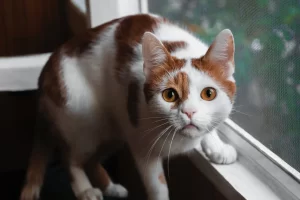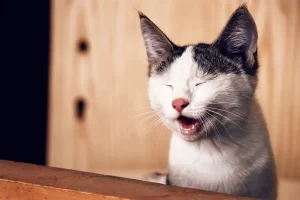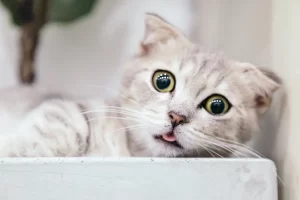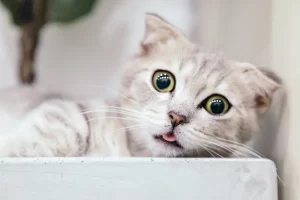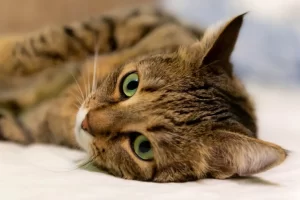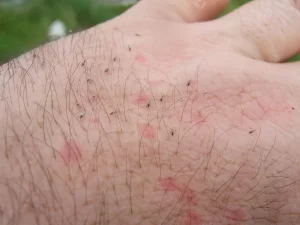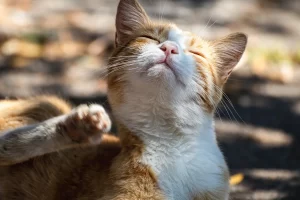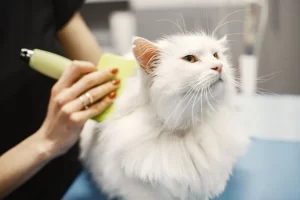If you’ve noticed your cat dragging its bottom across the floor or excessively licking its anal area, it may be experiencing a common issue known as cat scooting. Cat scooting can be caused by various underlying factors, such as anal gland issues, allergies, parasites, constipation, and more. While seeking veterinary care is essential for proper diagnosis and treatment, there are also home remedies for cat scooting that can help alleviate discomfort and manage the condition. In this article, we will explore a comprehensive guide on home remedies for cat scooting, including diet and nutrition, managing allergies, dealing with parasites, herbal remedies, hygiene and grooming, environmental enrichment, behavioral modifications, and things to avoid doing. Let’s delve into practical tips, examples, and suggestions to help your feline friend find relief from cat scooting.
Table of Contents
ToggleWhat is Cat Scooting?
If you’re a cat owner, you may have witnessed your furry friend dragging their bottom on the floor or ground or excessively licking their anal area. This peculiar behavior is commonly known as “cat scooting,” and while it may seem amusing, it can actually indicate an underlying health issue. As a responsible pet owner, it’s essential to understand what cat scooting is and how to address it to ensure your feline companion’s well-being.
Cat scooting refers to the act of a cat dragging its anus along the ground, sometimes after pooping or licking it excessively. It may be accompanied by discomfort, inflammation, or irritation in the anal area, and can be caused by various factors, including anal gland issues, allergies, parasites, constipation, or skin irritation. While cat scooting can be a normal behavior for a cat to clean their anal area occasionally, persistent or frequent scooting may indicate an underlying problem that requires attention.
Why is My Cat Dragging His or Her Butt on the Floor or Carpet?
Understanding the underlying causes of a cat rubbing its bottom on the ground is essential in addressing the issue effectively. Cat scooting can be caused by several health conditions, and identifying the root cause is crucial in determining the appropriate home remedies. Here are some common health conditions that can cause cat scooting:
- Anal gland issues: Cats have small anal glands located on either side of the anus that produce a scent-marking liquid. When these glands become blocked or infected, they can cause discomfort, inflammation, and scooting behavior. Home remedies for anal gland issues may include gently cleaning and expressing the anal glands, if recommended by a veterinarian, using gloves and a clean cloth or cotton ball. However, expressing anal glands should be done with caution and under veterinary guidance to avoid causing further harm or infection.
- Allergies: Cats can be allergic to various environmental allergens, such as pollen, dust, or certain foods, which can cause skin irritation and itching around the anal area. Identifying and managing potential allergens in the cat’s environment, such as regular cleaning, using hypoallergenic cat litter, or changing to a hypoallergenic diet, can help reduce allergic reactions and alleviate scooting behavior.
- Parasites: Internal parasites, such as worms or external parasites like fleas, can cause discomfort and irritation in the anal area, leading to scooting behavior. Regular deworming and flea prevention measures, as recommended by a veterinarian, can help prevent parasitic infestations and reduce scooting behavior. Note that your cat can get worms even without having fleas on them!
- Constipation: Cats can experience constipation, which can cause discomfort and difficulty in passing stools. Straining during bowel movements can lead to irritation in the anal area and scooting behavior. Home remedies for constipation may include dietary changes, such as increasing fiber intake with canned pumpkin or adding probiotics to the cat’s diet, providing ample hydration with fresh water, and encouraging exercise and physical activity to promote regular bowel movements.
- Skin irritation: Cats can develop skin irritations, such as dermatitis or wounds, around the anal area, which can cause discomfort and itching, leading to scooting behavior. Home remedies for skin irritation may include using natural remedies like aloe vera or coconut oil to soothe and moisturize the skin, avoiding harsh chemicals or fragrances in cleaning products or detergents used in the cat’s environment, and keeping the litter box clean and free from any irritants.
Symptoms of Cat Scooting
Identifying the symptoms of cat scooting is essential in addressing the issue promptly. Cats may exhibit various signs that they are experiencing scooting behavior. Here are some common symptoms to look out for:
- Dragging their bottom across the floor: One of the most noticeable signs of cat scooting is when a cat drags their bottom along the floor. This behavior is often seen as the cat sitting and pulling themselves forward using their front legs while dragging their hindquarters, including the anus, along the ground.
- Excessive licking of the anal area: Cats may also excessively lick their anal area if they are experiencing discomfort or irritation. They may groom themselves more frequently in an attempt to soothe the discomfort, which can be a sign of scooting behavior.
- Redness or inflammation around the anal area: Cats with scooting behavior may have redness, inflammation, or even open wounds around the anal area. These signs can indicate skin irritation, infection, or other underlying health issues that may be causing the scooting behavior.
- Discomfort or restlessness: Cats with scooting behavior may exhibit signs of discomfort or restlessness. They may repeatedly look back at their hindquarters, vocalize, or display signs of discomfort when sitting or grooming themselves.
- Changes in litter box behavior: Cats experiencing scooting behavior may also exhibit changes in their litter box behavior. They may have difficulty passing stools or may avoid using the litter box altogether due to discomfort or pain.
Overview of Home Remedies for Cat Scooting
Home remedies for cat scooting due to anal gland issues can include various approaches, such as diet and nutrition, managing allergies, dealing with parasites, herbal remedies, natural remedies for constipation, hygiene and grooming, environmental enrichment, and behavioral modifications. Let’s take a closer look at each of these:
- Diet and nutrition: Ensuring your cat has a healthy and balanced diet can help prevent anal gland issues. High-fiber diets, such as canned pumpkin or adding fiber supplements to the cat’s food, can help promote regular bowel movements and reduce the risk of anal gland blockage.
- Managing allergies: If your cat’s scooting behavior is related to allergies, identifying and managing potential allergens can be helpful. This may include using hypoallergenic cat litter, avoiding certain foods or treats that may trigger allergies, and reducing exposure to environmental allergens through regular cleaning and air purifiers.
- Dealing with parasites: Regular deworming and flea prevention measures, as recommended by a veterinarian, can help prevent parasitic infestations that may cause scooting behavior. Using vet-approved flea prevention products and keeping your cat’s living environment clean can be effective in preventing parasites.
- Herbal remedies: Some herbal remedies, such as calendula or chamomile, have anti-inflammatory properties and can help soothe irritated skin around the anal area. However, it’s important to consult with a veterinarian before using any herbal remedies to ensure they are safe and appropriate for your cat.
- Natural remedies for constipation: If constipation is the underlying cause of scooting behavior, natural remedies such as adding more water to the cat’s diet, providing regular exercise, and using probiotics or digestive enzymes may help promote regular bowel movements and alleviate discomfort.
- Hygiene and grooming: Maintaining good hygiene and grooming practices for your cat can help prevent anal gland issues. Regularly checking and cleaning your cat’s anal area, and keeping the fur around the area trimmed and clean can help prevent blockage and irritation.
- Environmental enrichment: Providing environmental enrichment, such as scratching posts, toys, and hiding spots, can help reduce stress and anxiety in cats, which may contribute to scooting behavior. A relaxed and enriched environment can promote overall well-being and prevent stress-related health issues.
- Behavioral modifications: Addressing any underlying behavioral issues, such as anxiety or stress, through behavior modification techniques, may help reduce scooting behavior. This can include providing regular playtime and exercise, using calming pheromones or supplements, and providing a routine and structured environment for your cat.
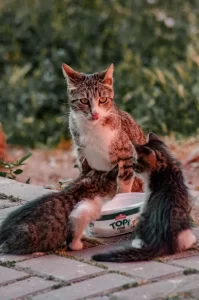
How Diet and Nutrition Can Impact Cat Scooting
A healthy diet and proper nutrition are crucial for maintaining optimal digestive health in cats and reducing the risk of anal gland issues, which can contribute to scooting behavior. Here are some practical tips and suggestions on how diet and nutrition can help:
- High-fiber diet: Including adequate fiber in your cat’s diet can promote regular bowel movements, which can help prevent constipation and reduce the risk of anal gland blockage. You can feed your cat a commercial cat food that is specifically formulated with higher fiber content, or you can add fiber-rich foods to their diet, such as canned pumpkin or psyllium husk powder (in consultation with your veterinarian for proper dosage).
- Moisture-rich diet: Ensuring your cat has enough water intake is essential for maintaining healthy digestion. Cats are known to have low thirst drive, so feeding them moist or wet food can help increase their water intake. Consider feeding your cat wet cat food or adding water to their dry food to help maintain proper hydration and promote regular bowel movements.
- Avoiding table scraps and inappropriate foods: Feeding your cat table scraps or inappropriate human foods can lead to digestive issues and an increased risk of anal gland problems. Avoid feeding your cat foods that are high in fat, spicy, or overly processed, as these can contribute to gastrointestinal upset and irregular bowel movements.
- Regular feeding schedule: Establishing a consistent feeding schedule for your cat can help regulate their digestion and prevent constipation. Avoid free-feeding (leaving food out all day) and instead feed your cat small, regular meals at the same time each day to promote healthy digestion and prevent overeating.
- Monitoring weight and portion control: Keeping your cat at a healthy weight through appropriate portion control can help prevent obesity-related digestive issues. Overweight cats are more prone to anal gland problems and constipation, so consult with your veterinarian to determine the appropriate amount of food to feed your cat based on their weight, age, and activity level.
Allergy Management for Cat Scooting: Tips and Tricks for a Healthier Environment
Allergies can be a common trigger for cat scooting, and managing potential allergens in your cat’s environment can help reduce the risk of allergic reactions and subsequent scooting behavior. Here are some practical tips and suggestions for managing allergies in cats:
- Identifying allergens: It’s important to identify potential allergens that may be triggering allergies in your cat. Common allergens for cats include pollen, dust mites, mold spores, certain foods, and fleas. Work with your veterinarian to determine the specific allergens that may be affecting your cat through allergy testing or elimination diets.
- Diet and nutrition: In some cases, adjusting your cat’s diet may be necessary to manage food allergies. Your veterinarian may recommend a hypoallergenic or limited ingredient diet for your cat to avoid triggering allergens. It’s important to strictly adhere to the recommended diet and avoid feeding your cat any treats or table scraps that may contain allergens.
- Grooming: Regular grooming can help reduce the presence of allergens on your cat’s fur and skin. Brush your cat’s coat regularly to remove loose hair, dander, and potential allergens. If your cat has a history of skin allergies, your veterinarian may recommend medicated shampoos or wipes to help manage the condition.
- Environmental changes: Making changes in your cat’s environment can also help manage allergies. Keep your home clean and well-ventilated to reduce the presence of dust, pollen, and other allergens. Use air purifiers with HEPA filters to trap allergens in the air. Wash your cat’s bedding, toys, and litter box regularly to minimize allergen exposure.
- Flea prevention: Flea bites can trigger allergic reactions in cats, leading to skin irritation and scooting behavior. Use regular flea prevention measures, such as topical or oral flea medications, to keep your cat flea-free. Keep your home and surroundings clean to prevent flea infestations.
Parasite Prevention and Treatment for Cat Scooting
Parasites, such as worms and fleas, can be a common cause of scooting in cats (learn more on What Fleas Do to Cats and Kittens). Managing parasites naturally can help prevent scooting behavior and promote your cat’s overall health. Here are some practical tips and suggestions for dealing with parasites in cats:
- Regular deworming: Worms, such as roundworms, hookworms, and tapeworms, can cause scooting in cats. Consult with your veterinarian to determine an appropriate deworming schedule for your cat based on their age, lifestyle, and risk of exposure to parasites. There are various deworming medications available, including natural options that use ingredients such as pumpkin seeds or diatomaceous earth, which can help eliminate parasites from your cat’s digestive system.
- Flea prevention: Fleas can also cause irritation and itching, leading to scooting behavior in cats. Use regular flea prevention measures, such as flea collars, topical or oral medications, and natural remedies such as diatomaceous earth or essential oils, to keep your cat flea-free. Remember to choose products that are specifically formulated for cats, as some flea treatments for dogs can be toxic to cats.
- Environmental cleanliness: Keeping your cat’s environment clean is crucial in preventing and managing parasites. Regularly clean your cat’s bedding, litter box, and surrounding areas to reduce the risk of fleas, worms, and other parasites. Vacuum your home frequently, paying close attention to areas where your cat spends time, to remove fleas and their eggs.
- Natural remedies: There are several natural remedies that can help deter parasites in cats. For example, adding food-grade diatomaceous earth to your cat’s food can help eliminate internal parasites. Some herbs, such as wormwood, black walnut, and garlic, are believed to have anti-parasitic properties and can be used as supplements or incorporated into your cat’s diet. However, it’s important to consult with your veterinarian before using any natural remedies to ensure they are safe and appropriate for your cat.
- Regular grooming: Regular grooming can help prevent flea infestations and reduce the risk of other external parasites, such as mites. Brush your cat’s coat regularly to remove loose hair, debris, and potential parasites. Keep your cat’s nails trimmed to prevent them from scratching and ingesting fleas or other parasites while grooming themselves.
- Outdoor control: If your cat is allowed to go outdoors, they may be at higher risk of encountering parasites. Consider keeping your cat indoors or providing a safe and controlled outdoor environment to reduce their exposure to parasites. Regularly inspect your cat’s fur and skin for any signs of fleas, ticks, or other parasites, and promptly remove them.
Herbal Relief for Cat Scooting Woes: Natural Remedies for Comfort and Healing
Herbal remedies can be a natural and gentle way to reduce inflammation and discomfort associated with cat scooting. Here are some safe and effective herbal remedies that you can consider using:
- Calendula: Calendula is known for its anti-inflammatory properties and can help soothe irritated skin around the anal area. You can make a calendula-infused oil by steeping dried calendula flowers in carrier oil, such as olive or coconut oil, for a few weeks. Strain the oil and apply it topically to the affected area with a clean cloth or cotton ball. Calendula oil can help reduce inflammation, promote healing, and provide relief from discomfort.
- Witch hazel: Witch hazel is a natural astringent that can help reduce inflammation and soothe irritated skin. You can dilute witch hazel with water and apply it topically to the anal area using a clean cloth or cotton ball. Witch hazel can help cleanse the area, reduce swelling, and provide relief from discomfort.
- Aloe vera: Aloe vera has anti-inflammatory and healing properties and can be used topically to soothe irritated skin. You can use fresh aloe vera gel or aloe vera gel from a trusted source and apply it directly to the affected area. Aloe vera can help reduce inflammation, promote healing, and provide relief from discomfort.
- Chamomile: Chamomile has anti-inflammatory and calming properties and can help soothe irritated skin. You can make chamomile tea by steeping chamomile flowers in hot water, then allowing it to cool. Use a clean cloth or cotton ball to apply the cooled chamomile tea to the anal area. Chamomile tea can help reduce inflammation, provide relief from discomfort, and promote healing.
- Coconut oil: Coconut oil has anti-inflammatory and moisturizing properties and can help soothe irritated skin. You can apply organic, cold-pressed coconut oil topically to the affected area. Coconut oil can help reduce inflammation, moisturize the skin, and provide relief from discomfort.
- Comfrey: Comfrey has anti-inflammatory and wound-healing properties (see other wound-healing natural antibiotics) and can be used topically to soothe irritated skin. You can make comfrey-infused oil by steeping dried comfrey leaves in carrier oil for a few weeks. Strain the oil and apply it topically to the affected area. Comfrey oil can help reduce inflammation, promote healing, and provide relief from discomfort.
Gentle Solutions for Cat Constipation: Natural Remedies for Bowel Health and Anal Gland Care
Regular bowel movements are essential for maintaining healthy anal glands in cats. Here are some natural remedies for constipation that can help promote regular bowel movements and prevent anal gland issues:
- Hydration: Adequate hydration is crucial for maintaining healthy bowel movements. Make sure your cat has access to clean and fresh water at all times. You can also consider offering wet food or adding water to dry food to increase your cat’s water intake. Dehydration can lead to constipation, so it’s important to keep your cat well-hydrated to promote regular bowel movements.
- Exercise: Regular exercise can help stimulate the digestive system and promote healthy bowel movements. Encourage playtime and physical activity to keep your cat active and help prevent constipation. Physical activity can help promote muscle tone in the gastrointestinal tract and aid in the smooth passage of feces.
- Laxatives: There are some natural laxatives that can be used under the guidance of a veterinarian to promote regular bowel movements in cats. Examples include lactulose or mineral oil. These laxatives can help soften the stool and facilitate its passage. However, it’s important to use laxatives only as directed by your veterinarian, as incorrect use or dosage can have adverse effects.
- Regular grooming: Cats may ingest excessive amounts of fur during grooming, which can contribute to constipation. Regular grooming, including brushing your cat’s coat to remove loose fur, can help reduce the ingestion of fur and prevent constipation.
- Avoid stress: Stress can impact a cat’s digestive system and contribute to constipation. Create a calm and stress-free environment for your cat, and minimize any changes or disruptions that may cause stress. Provide ample hiding spaces, perches, and playtime to help your cat feel secure and relaxed.
- Probiotics: Probiotics are beneficial bacteria that can help promote healthy gut function in cats. They can help regulate the gut microbiome, which plays a crucial role in digestion and bowel movements. You can ask your veterinarian about incorporating a high-quality feline-specific probiotic into your cat’s diet to promote regular bowel movements.
- Olive oil or coconut oil: These natural oils can help lubricate the digestive tract and promote smooth passage of feces. You can add a small amount (about 1/2 teaspoon for every 10 pounds of body weight) of olive oil or coconut oil to your cat’s food to help alleviate constipation. However, it’s important to consult with your veterinarian for appropriate dosage and to ensure these oils are safe for your cat.
- Increased litter box access: Make sure your cat has easy access to a clean litter box at all times. Cats are more likely to use the litter box regularly if it is easily accessible and clean. Provide multiple litter boxes in different areas of your home to encourage your cat to use them regularly and prevent constipation.
- Avoid dry food exclusively: Dry food tends to have lower moisture content compared to wet food, which can contribute to dehydration and constipation in cats. Consider incorporating wet food into your cat’s diet to increase their water intake and promote regular bowel movements. Consult with your veterinarian for appropriate dietary recommendations based on your cat’s age, health condition, and lifestyle.
- Increase playtime and physical activity: Regular playtime and exercise can help stimulate the digestive system and promote healthy bowel movements. Encourage your cat to engage in playtime and provide opportunities for physical activity, such as climbing, running, or chasing toys, to promote regular bowel movements.
- Avoid feeding human food: Human food may not be suitable for cats and can lead to digestive issues, including constipation. Avoid feeding your cat human food, especially fatty, greasy, or spicy foods, which can disrupt the digestive system and contribute to constipation.
- Adequate rest and relaxation: Cats require adequate rest and relaxation to maintain optimal health, including proper digestion. Make sure your cat has a comfortable and cozy resting space where they can relax and rest undisturbed. Adequate rest can help promote healthy bowel movements and prevent constipation.
Anal Gland Health for Cats: Proper Hygiene and Grooming Techniques
Hygiene and grooming are essential aspects of maintaining a healthy and comfortable anal area for cats. Here are some practical tips on proper hygiene and grooming practices:
- Regular cleaning of the anal area: Keep the anal area of your cat clean by gently wiping it with a damp, warm cloth. Avoid using harsh chemicals or strong fragrances that may cause skin irritation. You can also use unscented baby wipes specifically formulated for cats to clean the anal area.
- Trimming of fur around the anal area: Cats with long fur may benefit from having the fur around their anal area trimmed regularly. Long fur can trap feces and make it difficult for cats to clean themselves properly, leading to discomfort and potential anal gland issues. Use blunt-end scissors or seek the help of a professional groomer to safely trim the fur around the anal area.
- Avoiding scented litter or harsh chemicals: Avoid using scented litter or harsh chemicals in and around the litter box area, as these may cause skin irritation in the anal area. Opt for unscented litter and gentle, pet-safe cleaning products when cleaning the litter box area.
- Regular baths: Regular baths can help keep your cat’s coat and skin clean and healthy. However, it’s important to use a mild, feline-specific shampoo and avoid getting water or soap directly on the anal area to prevent irritation. Follow proper bathing techniques and rinse thoroughly to remove all the shampoo.
- Keeping the environment clean: Maintaining a clean living environment for your cat can help prevent the accumulation of dust, dirt, and other potential irritants that may cause discomfort or allergies. Regularly clean your cat’s bedding, toys, and living areas to promote overall hygiene and reduce the risk of skin irritations or allergies.
- Avoiding tight collars or harnesses: Tight collars or harnesses around the neck or waist can put pressure on the anal area, leading to discomfort and potential scooting behavior. Ensure that your cat’s collar or harness fits properly and is not too tight, allowing for comfortable movement without putting unnecessary pressure on the anal area.
- Regular grooming sessions: Regular grooming sessions, including brushing your cat’s coat, can help remove loose fur, dirt, and debris that may accumulate around the anal area. This can prevent the buildup of feces and reduce the risk of anal gland issues.
Stress-Free Cats: Environmental Enrichment to Prevent Scooting
Environmental enrichment plays a crucial role in keeping cats mentally and physically stimulated, reducing stress and anxiety, which can contribute to scooting behavior. Here are some practical tips for providing environmental enrichment for your cat:
- Provide ample play opportunities: Regular play sessions with interactive toys, such as feather wands or laser pointers, can help keep your cat physically active and mentally engaged. Rotate the toys regularly to keep them interesting and offer a variety of play options to prevent boredom.
- Offer scratching posts and climbing opportunities: Cats have a natural instinct to scratch and climb. Providing appropriate scratching posts and climbing opportunities, such as cat trees or shelves, can help satisfy their natural behaviors and provide mental stimulation. Place them strategically in different areas of your home to encourage exploration and play.
- Create hiding spots and resting areas: Cats love to hide and have their own cozy resting spots. Create hiding spots with boxes, tunnels, or hideaway beds where your cat can feel safe and secure. Offer comfortable resting areas, such as cat beds or perches near windows, where your cat can relax and observe the surroundings.
- Use puzzle feeders or food-dispensing toys: Incorporate puzzle feeders or food-dispensing toys into your cat’s feeding routine. These toys require mental effort to obtain food, stimulating your cat’s natural hunting instincts and providing mental enrichment. Consult with your veterinarian to ensure the right type and size of toys for your cat’s dietary needs.
- Rotate and introduce new toys and objects: Cats can become bored with the same toys or objects over time. Rotate toys, introduce new toys or objects, and rearrange the environment periodically to keep things fresh and interesting for your cat.
- Provide outdoor access or a safe window view: If your cat is allowed outdoors or has access to a safe outdoor enclosure, it can provide ample opportunities for exploration, hunting, and mental stimulation. Alternatively, providing a safe window view of the outdoors can also be stimulating for cats, allowing them to observe birds, squirrels, and other outdoor activities.
- Consider cat-friendly plants: Some cats enjoy nibbling on plants, which can provide additional sensory stimulation. Consider offering safe and cat-friendly plants, such as cat grass or catnip, as a form of environmental enrichment.
Medical Treatments and Medications for Cat Scooting
Medical treatments and medications can also be used in managing cat scooting, especially if the underlying cause is related to anal gland issues or other health conditions. Here are some specific and practical examples:
- Anal gland expression: If your cat’s scooting is due to anal gland issues, your veterinarian may need to manually express the anal glands to relieve impacted or infected glands. This should only be done by a trained professional and should not be attempted at home without proper knowledge and guidance.
- Prescription medications: Your veterinarian may prescribe medications to address underlying health conditions that are contributing to scooting, such as antibiotics for infections, anti-inflammatory medications for inflammation, or deworming medications for parasites. Follow your veterinarian’s instructions carefully and administer the prescribed medications as directed.
- Topical treatments: Your veterinarian may recommend topical treatments, such as medicated wipes or creams, to soothe irritated skin in the anal area and reduce inflammation. These may contain ingredients like hydrocortisone, witch hazel, or aloe vera. Always follow the instructions provided by your veterinarian or the product label for proper application.
- Over-the-counter products: There are some over-the-counter products that may help in managing cat scooting. These may include natural or herbal remedies, such as calendula or witch hazel-based creams or wipes that can help soothe the irritated skin. Always read the product label carefully and follow the instructions for use.
Frequently Asked Questions about Cat Scooting:
Why is my cat dragging its butt on the floor?
Cat scooting, or dragging its butt on the floor, is often a sign of anal gland issues, constipation, or irritation in the anal area. It can also indicate the presence of parasites or other underlying health issues.
Why does my cat rub its butt on the ground?
Cats may rub their butts on the ground as a way to alleviate discomfort or irritation in the anal area. It can be due to anal gland issues, constipation, or other underlying health problems.
My cat scoots after pooping, is that normal?
If your cat scoots after pooping, it may indicate that it is trying to relieve discomfort or irritation in the anal area. It could be due to anal gland issues, constipation, or other health concerns. It’s best to consult your vet for a proper diagnosis.
What should I do if my cat keeps wiping its bum on the floor?
If your cat is repeatedly wiping its bum on the floor, it could be a sign of anal gland issues, constipation, or other health problems. It’s important to consult your vet to determine the underlying cause and appropriate treatment.
My cat scoots after using the litter box, is that normal?
Scooting after using the litter box can be a sign of anal gland issues, constipation, or other health issues in cats. It’s recommended to consult your vet for a proper diagnosis and treatment.
Why does my cat rub its butt on the carpet?
Cats may rub their butts on the carpet as a way to alleviate discomfort or irritation in the anal area. It can be due to anal gland issues, constipation, or other underlying health problems.
My cat is scooting and has diarrhea, what could be the cause?
Scooting accompanied by diarrhea in cats can be indicative of various health issues such as gastrointestinal upset, colitis, or parasitic infections. It’s important to consult your vet for proper evaluation and treatment.
Is my kitten scooting after pooping normal?
If your kitten is scooting after pooping, it may indicate anal gland issues, constipation, or other health concerns. It’s best to consult your vet for a proper diagnosis and appropriate treatment for kittens.
Can constipation cause my cat to scoot?
Yes, constipation can cause discomfort in the anal area, leading to scooting behavior in cats. Ensuring your cat has a healthy diet, hydration, and regular exercise can help prevent constipation and reduce scooting.
Are there any home remedies for cat scooting due to constipation?
There are several home remedies for cat scooting due to constipation, such as dietary changes, increased hydration, and providing opportunities for exercise. However, it’s important to consult your vet for proper diagnosis and guidance on appropriate remedies for your cat’s individual needs.



